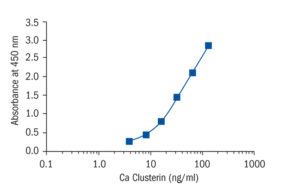Clusterin Canine ELISA
lusterin is a 75–80 kD disulfide-linked heterodimeric protein containing about 30% of N-linked carbohydrate rich in sialic acid, but truncated forms targeted to the nucleus have also been identified.
The precursor polypeptide chain is cleaved proteolytically to remove the 22-mer secretory signal peptide and subsequently between residues 227/228 to generate the alpha and beta chains. These are assembled anti-parallel to give a heterodimeric molecule in which the cysteine-rich centers are linked by five disulfide bridges and are flanked by two predicted coiled-coil alpha-helices and three predicted amphipathic alpha-helices. Clusterin is a heavily N-glycosylated protein.
Across a broad range of species clusterin shows 70% to 80% of sequence homology. It is ubiquitously expressed in most mammalian tissues and can be found in plasma, milk, urine, cerebrospinal fluid and semen.
It is able to bind and form complexes with numerous partners such as immunoglobulins, lipids, heparin, bacteria, complement components, paraoxonase, beta amyloid, leptin and others. Clusterin has been ascribed a plethora of functions such as phagocyte recruitment, aggregation induction, complement attack prevention, apoptosis inhibition, membrane remodelling, lipid transport, hormone transport and/or scavenging, matrix metalloproteinase inhibition.
A detailed mechanism of clusterin has not been defined. One tempting hypothesis says that clusterin is an extracellular chaperone protecting cells from stress induced by degraded and misfolded protein precipitates.Clusterin is up- or downregulated on the mRNA or protein level in many pathological and clinically relevant situations including cancer, organ regeneration, infection, Alzheimer disease, retinitis pigmentosa, myocardial infarction, renal tubular damage, autoimmunity and others.
Features
- It is intended for research use only
- The total assay time is less than 3.5 hours
- The kit measures clusterin in canine serum and urine
- Assay format is 96 wells – Quality Controls are canine serum based
- Standard is canine serum based native protein
- Components of the kit are provided ready to use, concentrated or lyophilized
Research topic
Animal studies, Oncology, Others, Renal disease, Sepsis
Type
Sandwich ELISA, Biotin-labelled antibody
Applications
Serum, Urine
Sample Requirements
serum samples: 5 µl/well
urine samples: 50 µl/well
Storage/Expiration
Store the complete kit at 2–8°C. Under these conditions, the kit is stable until the expiration date (see label on the box).
Calibration Curve

Calibration Range
4–128 ng/ml
Limit of Detection
0.2 ng/ml
Intra-assay (Within-Run)
n = 8; CV = 4.3%
Inter-assay (Run-to-Run)
n = 8; CV = 6.2%
Spiking Recovery
93,10%
Dilutation Linearity
102,00%
Crossreactivity
| bovine | Non-detectable |
|---|---|
| cat | Yes (recommended dilution 1:3000) |
| dog | Yes |
| goat | Non-detectable |
| hamster | Non-detectable |
| horse | Non-detectable |
| monkey | Non-detectable |
| mouse | Non-detectable |
| pig | Non-detectable |
| rabbit | Non-detectable |
| rat | Non-detectable |
| sheep | Non-detectable |
| chicken | Not tested |
| human | Non-detectable |
– Garcia-Martinez JD, Tvarijonaviciute A, Ceron JJ, Caldin M, Martinez-Subiela S. Urinary clusterin as a renal marker in dogs. J Vet Diagn Invest. 2012 Mar;24 (2):301-6
– Martineau AS, Leray V, Lepoudere A, Blanchard G, Bensalem J, Gaudout D, Ouguerram K, Nguyen P, ORCID: http://orcid.org/0000-0002-4263-025X. A mixed grape and blueberry extract is safe for dogs to consume. BMC Vet Res. 2016;12 (1):162
– McDuffie JE, Chen Y, Ma JY, Lee S, Lynch KM, Hamlin DM, Nguyen L, Rizzolio M, Sonee S, Snook S. Cisplatin nephrotoxicity in male beagle dogs: next-generation protein kidney safety biomarker tissue expression and related changes in urine. Toxicology Research. 7th June 2016;
– Tvarijonaviciute A, Ceron JJ, Holden SL, Biourge V, Morris PJ, German AJ. Effect of weight loss in obese dogs on indicators of renal function or disease. J Vet Intern Med. 2013 Jan-Feb;27 (1):31-8

